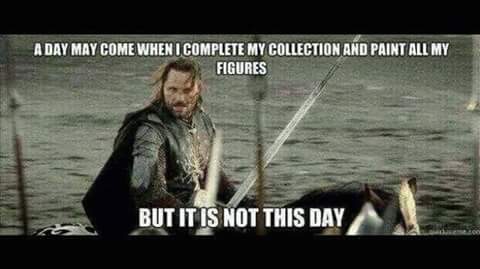Besides a stone bridge across the river, a pontoon bridge had been build by the defending Coalition and a supply depot was also in close proximity. Holding all three would be a decisive victory for someone, two a marginal victory and only one each a draw. Ownership meant that you physically occupied it and no enemy unit in good order was within charge distance.
The Coalition had six battalions of Hanoverians, four Brunswick and two Hessian. Two good units of Hanoverian cavalry and three batteries finished out the defensive forces. All but one of the battalions was of 16 figures. The attacking French had four Swiss battalions, two German, and twelve French (two grenadier). Battalions were roughly 50-50 of 12 or 16 figures each. Four batteries (one heavy) and three cavalry regiments rounded out the attackers under St. Germain, aka. Bob Rondou.
The plan of Baron Rondou called for the Swiss and the two German battalions with the cavalry to take a sweeping attack against the Allied left. One French brigade would keep the Allies honest in the center, one would remain in reserve, and another go against the Allied right. The passage of turns was carefully noted, though only I paid attention.
Things developed quickly with columns moving on the left and right quickly as the Allies decided against a defense forward along the walls but stayed concentrated by the objectives. The Allied cavalry thought it saw an opportunity and raced out to try and force a separation of the French wings and significantly delay their advance. Things went wrong though and the cavalry rapidly found itself surrounded. With little else to do they put spurs down and charged an infantry unit. Vulnerable artillery and infantry with exposed flanks waited with bated breath. The defensive volley was a total whiff and with great confidence they cavaliers crashed into the infantry. When all was said and done the cavalry had a -4 modifier against the French 2d6 roll with the low dice throw winning. Incredibly, they lost. The first of a wretched day of dice rolling by Count Prochniak. When the cavalry routed shortly thereafter, a string of three "3s" in a row left an otherwise undamaged line shaken.
Meanwhile the Swiss and their attendant cavalry maneuvered, softened with artillery and closed for the kill. About this time, after two hours of table game play, I had Todd (Count Prochniak) roll a d6. Hmmm, a "1." Roll another I said. "Hmmm, a "2." The game went on.
The center began to close with the Allies, who were briefly hamstrung by the series of shaken rolls. On the Allied left the French and Hessians danced about for position, then began infiltrating slowly through the woods. Two turns after the dice rolls I told everyone they saw a tall dust cloud, the kind created by cavalry, on the road coming from the far right. Next turn a brigade of cavalry, heavies and lights, thundered onto the table having ridden to the sound of the guns.
 |


No comments:
Post a Comment